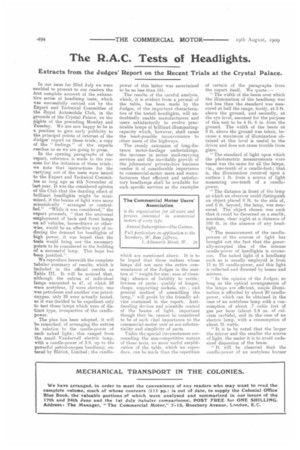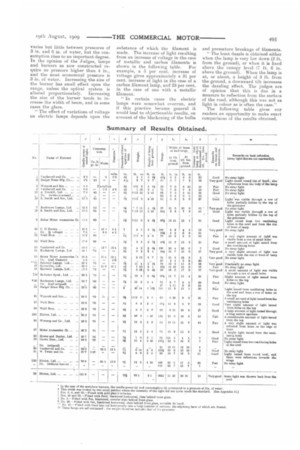The R.A.C. Tests of Headlights.
Page 16

Page 17

If you've noticed an error in this article please click here to report it so we can fix it.
Extracts from the Judges' Report on the Recent Trials at the Crystal Palace.
In our issue for 22nd July we were • enabled to present to our readers the first complete account of the exhaustive series of headlamp tests, which was successfully carried out by the Expert and Technical Committee of the Royal Automobile Club, in the grounds of the Crystal Palace, on the nights of the preceding Monday and Tuesday. We are now .happy to be in a position to give early publicity to the principal points of interest of the Judges' report on these trials ; a copy of the " findings " of the experts reaches us as we are going to press.
In. the opening paragraphs of the report, reference is made to the reasons for the initiation of these trials ; we note that instructions for the .carrying out of the tests were issued to the Expert and Technical Committee so long ago as 4th November of last year. It was the considered opinion -of the Club that the dazzling effect of brilliant headlights might be minimized, if the beams of light were more scientifically " arranged or controltad." "While it was considered," the report proceeds, " that the universal employment of back and front lamps on all vehicles, horse-drawn or otherwise, would be an effective way of reAucing the demand for headlights of ;high power, it was hoped that the tests would bring out the necessary points to be considered in the building of a successful lamp. This hope has teen justified."
We reproduce herewith the complete tabular summary of results, which is included in the official results as Table Ill. It will be noticed that, although the entries of individual lamps amounted to 47, of which 33 were acetylene, 12 were electric, one was petroleum and another was petrol-oxygen, only 33 were actually tested, as it was decided to be expedient only to test those lamps which were of distinct type, irrespective of the candlepower.
The plan has been adopted, it will be remarked, of arranging the entries in relation to the candle-power of each naked light; this ranged from the small Vandervell electric lamp, with a candle-power of 3.9, up to the powerful petrol-oxygen headlamp. entered by Bleriot, Limited ; the candle
power of this latter was ascertained to be no less than 181.
The results of the careful analysis, which, it is evident from a perusal of the table, has been made by the Judges, of the important characteristics of the tested headlights, will undoubtedly enable manufacturers and users satisfactorily to evolve practicable lamps of brilliant illuminatingcapacity which, however, shall cause the least-possible inconvenience to other users of the highways.
The steady extension of long-distance motor-haulage undertakings, the increase in motor mail-carrying services and the inevitable growth of the job masters' private-hire business render it of considerable importance to commercial-motor users and manufacturers that efficient and satisfactory headlamps shall be available for such specific services as the examples which are mentioned above. It is to be hoped that those makers whose lamps did not earn the entire commendation of the Judges in the matters of " weight for size ; ease of cleaning; absence of liability to rattle; fewness of parts ; quality of hinges, clasps, supporting sockets, etc.; and general method of assembling the lamp," will profit by the friendly advice contained in the report. Antidazzling devices and scientific control of the beams of light, important though they be, cannot be considered to be of such vital importance to the commercial-motor user as are substantiality and simplicity of parts.
Under the special circumstances surrounding the non-competitive nature of these tests, no more useful amplification of the table, which we reproduce, can be made than the repetition of certain of the paragraphs from the report itself. We quote: " The width of the beam over which the illumination of the headlamp was not less than the standard was measured at half the range, firstly, at 3 ft. above the ground, and secondly, at the eye level, assumed for the purpose of this test to be 4 ft. 6 in, from the ground. The width of the beam at 3 ft. above the ground was taken, because a maximum of illumination obtained at this level is useful to the driver and does not cause trouble from glare.
"The standard of light upon which the photometric measurements were based was the same for all the lamps, viz., one-tenth of a candle-foot; that is, the illumination received upon a surface 1 ft. from a source of light measuring one-tenth of a candlepower. "The distance in front of the lamp at which an observer could distinguish an object placed 6 ft. to the side of, and 6 ft. beyond, the lamp, was measured. The object chosen was such that it could be discerned on a starlit, moonless, clear night at a distance of 100 ft. in the absence of any headlight.
"The measurement of the candlepowers of the sources of light has brought out the fact that the generally-accepted idea of the intense candle-power of headlights is erroneous. The naked light of a headlamp such as is usually employed is from 15 to 25 candle-power, and this light is collected and directed by lenses and mirrors.
" In the opinion of the Judges, so long as the optical arrangements of the lamps are efficient, ample illumination is afforded by about 20 candlepower, which can be obtained in the case of an acetylene lamp with a consumption of about .7 cubic feet of gas per hour (about 2.8 oz. of calcium carbide), and in the case of an electric lamp, with a consumption a about 21 watts.
" It is to be noted that the larger the mirror and the smaller the source of light, the easier it is to avoid undesired dispersion of the beam. " It will be observed that the candle-power of an acetylene burner varies but little between pressures of 3 in. and 6 in. of water, but the consumption rises to an important degree. In the opinion of the Judges, lamps and burners as now constructed require no pressure higher than 4 in., and the most economical pressure is 3 in. of water. Increasing the size of the burner has small effect upon the range, unless the optical system is altered proportionately. Increasing the size of the burner tends to increase the width of beam, and in some cases the glare.
"The effect of variations of voltage on electric lamps depends upon the substance of which the filament is made. The increase of light resulting from an increase of voltage in the case of metallic and carbon filaments is shown in the following table. For example, a 5 per cent. increase of voltage gives approximately a 31 per cent, increase of light in the case of a carbon filament lamp, and 23 per cent. in the case of one with a metallic filament.
" In certain cases the electric lamps were somewhat overrun, and if this practice became general it would lead to objectionable results, on account of the blackening of the bulbs and premature breakage of filaments.
"The least, dazzle is obtained either when the lamp is very low down (2 ft. from the ground), or when it is fixed above the canopy level (7 ft. 6 in, above the ground). When the lamp is at, or about, a height of 3 ft. from the ground, a downward tilt increases. the dazzling effect. The judges are of opinion that this is due in a measure to reflection from the surface of the road, although this was not as light in colour as is often the case."
The following table gives our readers an opportunity to make exact comparisons of the results obtained.






















